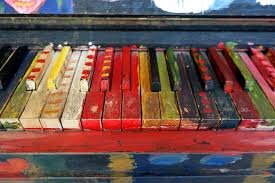Music and Arts…Painting From Music
Many people think that there is no common point of reference between music and arts, especially painting. But the reality is otherwise.
Music and art, particularly painting, have a close relationship. An environment in which music and art take place jointly affects our creative process. Environmental factors like colors, brightness or darkness, smell, and sounds trigger varying emotions and feelings within us. As such, these sensual experiences enter our creative process and affect our artworks. Evidence suggests that when a particular type of music and painting take place in the same environment, the result of the painting will be distinct.
Interpreting Music Through Arts
Many artists, psychologists, and musicologists agree on the relationship between music and the arts.
Many artists, psychologists, and musicologists agree on the relationship between music and the arts. Renowned Russian painter and art theorist Wassily Wassilyevich Kandinsky was so fascinated by the link between visual art and music that he used musical terms to name many of his paintings.
There is an opportunity to gain from accepting, exploring, and understanding how music affects arts, especially the painting process. To understand this process, try listening to different musical genres as you do a painting. The music will affect your subconscious mind, resulting in a different painting.
In other words, different types of music will affect your painting process. For example, it has a powerful effect on mark-making and color choices. If the music has a fast tempo, it will naturally incite fast mark-making.
On the other hand, slow music will affect how you choose colors. It will result in a painting that represents the emotions you experienced when listening to music. What this means is that you can interpret music through artwork, such as painting. Give it a shot and see how music alters the marks on your canvas.
Mood, Music, and Painting
Different people interpret paintings in different ways based on their feelings, emotions, and mood. When you look at a painting, it is not only the external depiction that you are looking at. Every picture holds in itself a deep and hidden meaning and feeling. You can get the feeling when you look at it carefully. You will comprehend the theme, mood, and emotions behind the painting. The point here is that the environment in which the artist made the painting will be visible in the final painting.
As explained above, music can affect your mood. In turn, your mood will affect your artwork. This means that if you are listening to a certain music genre while painting and then suddenly switch to another genre, the final painting will reflect this change.
Light Music and Painting
When you listen to sad music while painting, the painting will appear low and gloomy.
Light music will affect your painting process in a different way than fast or dark music because every genre of music sets a different mood, which will then be visible in your painting. To start with, play some light and peaceful music while painting a landscape. This will result in a painting that will look more beautiful and realistic. Whoever sees the painting will then have the same feelings that you experienced at the time of painting.
Painters can, unarguably, come up with realistic paintings when they are in a relaxed and calm mood. Combine light music with the lights turned on, and the final painting will light up with bright tones and colors. This happens because music and lights affect your subconscious mind to choose light colors. On the other hand, when you listen to sad music while painting, your mood will be visible in the final painting. The painting will appear low and gloomy.
If you want to paint something cheerful and pleasing, avoid listening to sad music. Instead, switch on a nice, pleasant, and positive genre. Even if you are feeling depressed and low at the time of painting, the music will calibrate your mood to positive. As such, your painting will be beautiful and upbeat. While music is useful as a temporary mood changer, it is not a lasting solution for your mood.
Fast Music and Painting
There are many examples where music has inspired many artists and vice versa. Colors in paintings represent different moods and feelings and music can affect your color choice. This is particularly true when it comes to fast music. When you paint while listening to fast or break music, it will result in an abstract painting with many colors. When you see an abstract painting, you will quickly understand that the artist was listening to fat music and experiencing a spin of emotions at the time of painting.
Depressing Music and Painting
If you are an art lover, chances are you already have seen many dark-themed paintings. The depressing depictions in the paining will make it evident that the painter was listening to sad music and experiencing depressing emotions.
It is natural to assume that an individual who is in a good mood cannot depict sad emotions in his paintings. Chances are the person came up with a depressing painting because he or she was having a bad time or sad moment. Or it can be because the person was listening to depressing music when working on the painting.
In case you are told to create a sad painting, but you are in a pleasant and relaxed mood, then switch on sad music and start painting. Doing so will make it easy for you to create a dark-themed or sad painting. The music will shift your mood from good to sad, which will then reflect in your artwork.
Final Thoughts
Music and art have a close relationship that has been endorsed by many studies and agreed upon by musicians, psychologists, and artists. The music genre you listen to while painting will affect your subconscious mind and swing your mood. This will result in a painting that reflects the type of music you were listening to while painting. We cannot disregard or jettison the linkage between music and painting. Instead, we should embrace this bond between these two fields of art.
Are you looking for a music lesson for yourself or your children? Contact us for more information or register now for our next music class.
Other articles of interest


